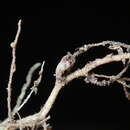pt-BR
nomes no trilho de navegação


Sinorhizobium/Ensifer és un gènere de bacteris que fan la fixació del nitrogen (rhizobia), tres dels quals (Sinorhizobium meliloti,[17][18] Sinorhizobium medicae[19] i Sinorhizobium fredii[20]) han estat seqüenciats.
Sinorhizobium és una ombinació del llatí medieval sino, -a (que significa "Xina"), el grec rhizo, -a (que significa "arrel"), i el neollatí bios (que significa "vida"). Per tal en conjunt significa "un bacteri que viu a les arrels a la Xina".[10][21]
Ensifer prové del terme del neollatí ensifer, que significa "que porta espasa".[6]
El mom Ensifer es va publicar l’any 1982 i el nom Sinorhizobium es va publicar el 1988. Per les regles del Codi Bacteriològic (Revisió de 1990) del International Committee on Systematics of Prokaryotes (ICSP), el nom més antic (Ensifer) té prioritat.[22] Tanmateix tots dos noms continuen sent usats en la bibliografia científica, sent el de Sinorhizobium el més comú.
La taxonomia actual està basada en la List of Prokaryotic names with Standing in Nomenclature (LPSN)[1][2] and National Center for Biotechnology Information (NCBI)[23] i la filogènia es basa en el The All-Species Living Tree Project[24]
Ensifer mexicanus Lloret et al. 2011
Sinorhizobium terangae De Lajudie et al. 1994
Sinorhizobium saheli De Lajudie et al. 1994
Sinorhizobium kostiensis Nick et al. 1999
Sinorhizobium kummerowiae Wei et al. 2002
Sinorhizobium fredii (Scholla and Elkan 1984) Chen et al. 1988[25]
Sinorhizobium americanum corrig. Toledo et al. 2004
Sinorhizobium arboris Nick et al. 1999
Ensifer garamanticus Merabet et al. 2010
Sinorhizobium meliloti (Dangeard 1926) De Lajudie et al. 1994
Ensifer numidicus Merabet et al. 2010
Ensifer adhaerens Casida 1982[25]
Sinorhizobium/Ensifer és un gènere de bacteris que fan la fixació del nitrogen (rhizobia), tres dels quals (Sinorhizobium meliloti, Sinorhizobium medicae i Sinorhizobium fredii) han estat seqüenciats.
Ensifer (often referred to in literature by its synonym Sinorhizobium) is a genus of nitrogen-fixing bacteria (rhizobia), three of which (Ensifer meliloti,[22][23] Ensifer medicae[24] and Ensifer fredii[25][26]) have been sequenced.
The generic epithet Ensifer derives from the Latin noun ensifer, "sword-bearer".[3] The synonym Sinorhizobium is a combination of Medieval Latin noun sino ("China"), the Classical Greek noun rhiza ("root"), and the Classical Greek noun bium ("life"). Thus, the Neo-Latin generic epithet of the synonym Sinorhizobium means "a Rhizobium isolated from China", in turn referring to the related genus Rhizobium ("root-associated life form").[18][9]
The name Ensifer was published in 1982 and the name Sinorhizobium was published in 1988 thus the latter is regarded as a later synonym and by the rules of the Bacteriological Code (1990 Revision) of the International Committee on Systematics of Prokaryotes (ICSP), the older name (Ensifer) takes priority.[27] In response to a request that the single extant species of Ensifer (Ensifer adhaerens) be moved to Sinorhizobium, a special ICSP subcommittee was formed to evaluate the request. It was ultimately ruled that Ensifer retained priority and that all Sinorhizobium species be transferred to the genus Ensifer.[28][29] However, both terms continue to be used in published scientific literature, with Sinorhizobium being the more common.[30]
Two species have been described which have since been reclassified into existing species: Sinorhizobium morelense (now Ensifer adhaerens)[27][31] and Sinorhizobium xinjiangense (now Ensifer fredii[32][33]—though some dissent exists[16][34]).
The currently accepted taxonomy is based on the List of Prokaryotic names with Standing in Nomenclature (LPSN).[18][19] The following phylogeny is based on whole-genome analysis.[35]
Ensifer outgroupThis phylogeny is based on a constrained analysis of the 16S ribosomal RNA.[35]
Ensifer outgroupEnsifer (often referred to in literature by its synonym Sinorhizobium) is a genus of nitrogen-fixing bacteria (rhizobia), three of which (Ensifer meliloti, Ensifer medicae and Ensifer fredii) have been sequenced.
见内文
中华根瘤菌属或剑菌属(学名:Sinorhizobium/Ensifer)是根瘤菌目根瘤菌科下的一属。该属中草木樨中华根瘤菌(Sinorhizobium meliloti)[4][5]与苜蓿中华根瘤菌(Sinorhizobium medicae)[6]进行过测序。
该属曾先后于1982年与1988年被命名为剑菌属(Ensifer)与中华根瘤菌属(Sinorhizobium)。根据国际原核微生物系统学委员会(International Committee on Systematics of Prokaryotes,ISCP)的《细菌学法规》(Bacteriological Code)规定,发表时间更早的名称有优先命名权。[7]由于有人提议将当时剑菌属的唯一物种附着剑菌(Ensifer adhaerens)并入中华根瘤菌属,为此ISCP设立了一个专门分委会对此进行评估。最终剑菌属保留其名称,并将所有中华根瘤菌属的物种并入剑菌属之中。[8][9]虽然如此,在大多学术著作中还是同时延用了这两个名称,而中华根瘤菌属一名则更为常见。
中华根瘤菌属或剑菌属(学名:Sinorhizobium/Ensifer)是根瘤菌目根瘤菌科下的一属。该属中草木樨中华根瘤菌(Sinorhizobium meliloti)与苜蓿中华根瘤菌(Sinorhizobium medicae)进行过测序。
他
シノリゾビウム属は硝酸細菌の一種で、植物と共生する根粒菌に属するグラム陰性の非芽胞形成好気性桿菌。リゾビウム科に属し、基準種はシノリゾビウム・フレディ。属名は中国のリゾビウム属を意味するが、世界各地で発見されている。農作物の生育に重要な役割を果たしており、いくつかの種の遺伝子が解読されている。
中国のダイズの根粒から発見された成長の早い根粒菌がDNA-DNA分子交雑法により既に発見されていたリゾビウム属やブラディリゾビウム属と異なっていたため設けられた属である。タルウマゴヤシやアカシアなどと共生する種がある。通常は土壌や水中に生息し鞭毛で運動するが、種によって特異的にマメ科植物の根に侵入して感染する。感染された部位は膨大して根粒を形成する。根粒の中ではバクテロイドと呼ばれる巨大な細胞に成長し、空気中の空気を取り込んでニトロゲナーゼで窒素の固定化を行う。固定化された窒素は植物に供給され、植物からは糖を摂取するという共生関係を持つが、根粒が老化するとバクテロイドは自由生活型の細胞に戻る。
シノリゾビウム属は硝酸細菌の一種で、植物と共生する根粒菌に属するグラム陰性の非芽胞形成好気性桿菌。リゾビウム科に属し、基準種はシノリゾビウム・フレディ。属名は中国のリゾビウム属を意味するが、世界各地で発見されている。農作物の生育に重要な役割を果たしており、いくつかの種の遺伝子が解読されている。
中国のダイズの根粒から発見された成長の早い根粒菌がDNA-DNA分子交雑法により既に発見されていたリゾビウム属やブラディリゾビウム属と異なっていたため設けられた属である。タルウマゴヤシやアカシアなどと共生する種がある。通常は土壌や水中に生息し鞭毛で運動するが、種によって特異的にマメ科植物の根に侵入して感染する。感染された部位は膨大して根粒を形成する。根粒の中ではバクテロイドと呼ばれる巨大な細胞に成長し、空気中の空気を取り込んでニトロゲナーゼで窒素の固定化を行う。固定化された窒素は植物に供給され、植物からは糖を摂取するという共生関係を持つが、根粒が老化するとバクテロイドは自由生活型の細胞に戻る。